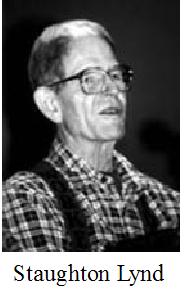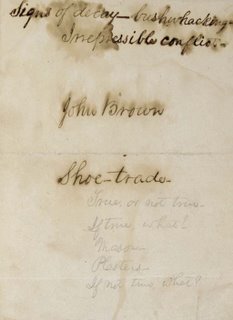On October 2, 2006, the Activities Board of Carnegie Mellon University, Pittsburgh, Pa., featured a forum entitled, "In the Shadow of John Brown: Toward a Renewed Interracial Radicalism." The free presentation was held at 8 p.m., at Baker Hall on campus and featured appearances by long-time activist Staughton Lynd, and the recorded presentation of the renowned deathrow journalist and social critic, Mumia Abu-Jamal. In addition, veteran civil rights activist and scholar, Vincent Harding, made impromptu remarks. The program was introduced and moderated by Prof. Johanna Fernandez, Visiting Professor of History at CMU and co-director of the Oral History Project of Black Pittsburgh. According to the Indepdent Media Center’s website, the event "was well-attended by a racially diverse, multi-generational crowd of college and high school students, local activists, and other Pittsburgh community members."
Not Quite Right, Professor
Fernandez, who identified herself as a professor of 20th century history specializing in the civil rights era, made substantial introductory remarks with respect to Brown, although she made the standard academic error of portraying the abolitionist as intent on launching a slave insurrection –something that Brown categorically denied and which he firmly avoided in his planning of his movement. Fernandez likewise erred in following the conventional notion that Brown did not properly inform the enslaved community of his efforts. Despite her sympathetic reading of Brown’s story, Fernandez’s errors reflect how the “objective” record of John Brown, and the history of the Harper’s Ferry raid in particular, have been heavily influenced by long-standing bias and error. (Having consulted Osborne Anderson’s narrative of the raid, Mumia did not make the same mistakes in his presentation.)
Brown, Not an Insurrectionist
Brown believed that some measure of force would be necessary to undermine slavery, but he could not condone insurrection or uprisings because they invariably resulted in wholesale fighting and slaughter, such as took place in the Nat Turner revolt a generation before the Harper’s Ferry raid. While Brown argued that slavery was a state of war and black people had a right to fight for their self-defense, he never extended that right beyond the point of arming fugitives in their effort to escape and to aid others from escaping from slavery as well. At no time did Brown prescribe or design an insurrectionary movement in which enslaved people would rise up and kill masters and heirs (many of the slave masters killed by Turner’s men were children, at least one was an infant). His goal was to syphon slaves from plantations and farms, drawing increasing numbers of them into a geographically expansive maroon movement with the goal of creating economic instability--not armed insurrection--in the South.
 A Voice from the Civil Rights Era
A Voice from the Civil Rights EraThe primary speaker making a live presentation was Staughton Lynd, from Youngstown, Ohio, noted as "a lifelong activist who directed the Mississippi Freedom Schools Project for the Student Nonviolent Coordinating Committee in 1964; organized against the Vietnam war; acted as a legal advocate for workers, and has written extensively on community organizing, labor issues, and pacifism." Lynd’s remarks vis-a-vis the Civil Rights movement were interesting, particularly in noting that in both the Harper’s Ferry Raid of 1859 and the Civil Rights movement of the 1960s, white and blacks struggled and died together for the cause of black freedom. Lynd’s focus was largely philosophical, his main concern being what implications history has for the future of any movement for justice.
His opening premise was that blacks and whites had become polarized in the 1960s as a result of the Black Power movement, the idea being that whites and blacks should work in their respective communities until they were better prepared to cooperate in equality-based alliances. However, Lynd reminded the audience, that was a now over forty years ago, and activists working for justice have yet to figure out how to reintegrate into a single movement across lines of color. (Of course, this assumes that white liberals are by and large socially mature enough to collaborate with blacks on equal terms, just as it assumes that blacks trust whites enough to collaborate with them in any significant measure.)
Lynd: Another Villard Finds Fault with Brown
With respect to John Brown, Lynd contended that, despite his redeeming qualities as an ally of black struggle, Brown is not a good model for future justice movements because of his use of violence in Kansas in 1856. It is no surprise that Lynd would raise the theme of the Pottawatomie killings. The role of the Browns in killing five pro-slavery terrorists is usually the "fly in the ointment" for Brown’s legacy, particularly among white critics, many of whom just cannot seem to contextualize, let alone forgive, the Browns’ motivation for the killings. Clearly this is true of activists like Lynd, who has a long and admirable history of devotion to non-violent activism. Like Brown’s cynical 20th century biographer Oswald Garrison Villard, those who advocate pacifist/non-violent political action are inevitably condescending in judgment of Brown for his do-or-die violence in Kansas. We cannot help but imagine that the liberal Villards and Lynds of this world would prefer that Brown, his sons, and their families would have allowed themselves to be murdered in their own beds rather than engage in a strategic preemptive strike.
No Need to Go There, Sir
Lynd also discussed the problem of building movements around charismatic leadership and, like Prof. Fernandez, represented Brown as lacking in democratic qualities because he was so focused on his divine calling as leader of his movement. This was also probably overdone as criticisms go. After all, Brown was not acting as the leader of a civil rights organization in peace time. He was acting as a military leader in a dangerous and volatile situation. As history shows, he could neither trust nor rely on very many people, and his reticence was to some larger measure necessary, especially given the long history of black liberation efforts undermined by loose lips. With all due respect to Mr. Lynd, his use of Brown as a negative example for contemporary activist strategy was largely self-serving and gratuitous. John Brown never joined the 19th century version of the civil rights movement because he was increasingly weary of noble people like Lynd, who believed that injustice can be preached, schooled, or journalized to death. There was an army of well-organized, democratically driven abolitionists like Lynd in the 19th century, but as biographer David Reynolds has observed, none of them managed to kill slavery as did John Brown.
 Death Row Defender of John Brown
Death Row Defender of John BrownAs the IMC website says, “Mumia Abu-Jamal is a former Black Panther currently on death Row at SCI-Greene prison in Southwestern Pennsylvania. Evidence suggests he is falsely imprisoned for his political beliefs.” Mumia writes and prepares radio commentaries on justice issues, and his comments on Brown–in response to Lynd’s presentation, were pre-recorded for the event. Mumia questioned the trendy notion largely among white intellectuals) of John Brown as a terrorist, arguing that violent acts perpetrated on behalf of the state or some powerful private interest have always been condoned by society, and even characterized in patriotic and heroic terms. In illustration , Mumia pointed out that there is a statue of the Confederate murderer and Klan terrorist, Nathan Bedford Forrest, in Washington, D.C., although there is no statue of John Brown. With our nation’s heroic pantheon so full of killers and slave masters, Mumia reasoned, it is unjust that violent acts perpetrated by justice-seekers are condemned as terrorism.
Not A Fair Contrast, Mumia
Of course, Mumia’s pro-Brown treatment notwithstanding, the issue of violence in Brown’s case still begs closer examination. The Pottawatomie killings of 1856 were an unfortunate exception in Brown’s life, and were indicative of an extremely unusual, volatile, and treacherous political dilemma that necessitated extreme action in a vacuum of lawlessness and lack of police protection. At Harper’s Ferry, Brown shied away from violence and bloodshed and virtually ruined himself by his own human sympathies in waiting upon and negotiating with his prisoners, especially the slave masters.
He Walked the Line
Mumia meant well, but he should never put Brown up as the counterpart to the homicidal racist, Nathan Bedford Forrest. On his worst day, John Brown was not even a Clint Eastwood-type of character, fighting for black liberation. He was a radical Christian reformer who tried to walk a thin, moral line between impotent pacifist activism and insurrectionary/revolutionary bloodletting. When he failed, he was pleased to give his life on the gallows like a true Christian witness (which is the origin of the word "martyr.") Still, to Mumia’s great credit, he actually did his homework and quoted extensively from A Voice from Harper’s Ferry, the narrative of Osborne Anderson (one of the few surviving John Brown raiders), written two years after the raid. In the end, it was Anderson’s words–mediated a century-and-a-half later in the resonant tones of Mumia’s voice–that brought the most light to the story of John Brown the man who lived.
By way of historical footnote, Vincent Harding, who was not scheduled to speak but fortuitously happened to be in town for the event, did offer comments and led questions-and-answers with the audience. However the IMC's recording has Harding making no remarks about Brown. This is disappointing, especially since he handled Brown as a historian in his classic study of 19th century black history, There is a River. Harding handled him a bit roughly, I should add, since he portrayed Brown as racially condescending--an unfair and reactionary interpretation that he has hopefully reconsidered over the past two decades.
Audio segments of this forum are available on the website of the Independent Media Center at: http://pittsburgh.indymedia.org/news/2006/10/25055.php.">http://pittsburgh.indymedia.org/news/2006/10/25055.php. The text of Mumia’s presentation can also be found on line at Prison Radio,
http://www.prisonradio.org/JohnBrown.htm.


